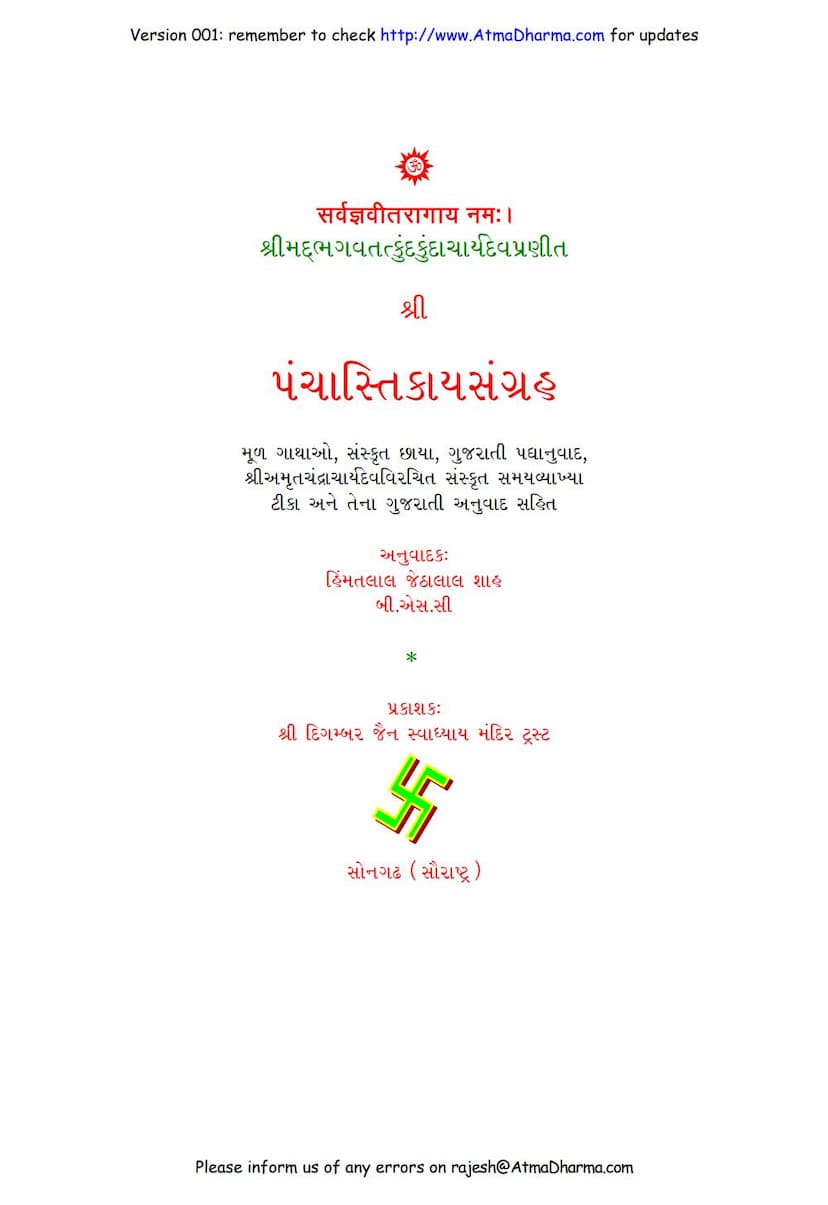Punchaastikaai Sangrah
Added to library: September 2, 2025

Summary
The provided text is a detailed summary and commentary on the Jain text "Panchastikaya Sangraha" by Kundkundacharya, with a Gujarati translation and Sanskrit commentary. The "Panchastikaya Sangraha" is a foundational Jain scripture that explains the nature of existence through the concept of "astikayas" (substances that have both existence and extension).
Here's a breakdown of the key themes and concepts covered in the text:
1. The Textual Structure and Its Purpose:
- Authoritative Source: The text highlights the paramount importance of Kundkundacharya's works in the Digambara Jain tradition, equating them to the words of the Tirthankaras themselves.
- Commentary: It emphasizes the inclusion of Amritchandracharya's "Samayavyakhyana" (Sanskrit commentary) and its Gujarati translation, along with the original Prakrit verses (Gathas) and a Gujarati poetic translation, making the scripture accessible.
- Spiritual Guidance: The introduction and dedications reveal a deep reverence for spiritual preceptors like Shri Kanji Swami, whose discourses are credited with unlocking the profound secrets of these scriptures and inspiring the translation work.
- Objective: The primary aim of the text is to expound the core principles of Jain philosophy, particularly the nature of reality, the path to liberation, and the understanding of essential spiritual concepts for the benefit of seekers (mumukshus).
2. Core Jain Philosophical Concepts Explained:
The "Panchastikaya Sangraha" and its commentary delve into fundamental Jain metaphysics, focusing on:
-
The Six Substances (Dravyas) and Five Astikayas: The text systematically explains the six substances of Jainism:
- Jiva (Soul): Described as conscious, possessing infinite knowledge, perception, bliss, and power, but currently bound by karmic impurities. The commentary elaborates on the Jiva's essence, its relationship with the body, and its journey through different states of existence.
- Pudgala (Matter): Explained as the substance responsible for physical form, including qualities like color, taste, smell, and touch. It is described as the cause of various forms of existence (like the six types of Pudgala based on their constitution).
- Dharma (Motion Principle): Explains Dharma as the substance that facilitates motion for other substances, without itself moving.
- Adharma (Rest Principle): Explains Adharma as the substance that facilitates rest, without itself being stationary.
- Akasha (Space): Described as the all-pervading substance that provides space for all other substances to exist and move.
- Kala (Time): While not an astikaya, time is explained as the necessary condition for change and modification (parinama) of substances.
- Astikayas: Among these, Jiva, Pudgala, Dharma, Adharma, and Akasha are classified as astikayas because they have both existence (asti) and extension (kaya), i.e., they occupy space and have extension. Kala, while existing, does not have extension, hence it is not an astikaya.
-
Nayas (Standpoints): The text highlights the Jain principle of Nayas, explaining the importance of understanding reality from different standpoints, particularly the Nishchay Naya (Absolute/Real Standpoint) and Vyavahar Naya (Conventional/Relative Standpoint). The commentary emphasizes that the Nishchay Naya reveals the true, unadulterated nature of substances, while Vyavahar Naya provides a conventional understanding based on worldly correlations. The importance of correctly interpreting statements through the lens of these nayas is stressed to avoid philosophical pitfalls.
-
Karma Theory: The text touches upon the concept of karma as Pudgala (matter) that adheres to the soul due to its passions (kashayas) and karmic tendencies. The interaction between Jiva and Pudgala in the cycle of birth and death, driven by passions, is a central theme.
-
Path to Liberation (Moksha Marga): The ultimate goal of understanding these principles is liberation (moksha). The text explains the path to liberation through:
- Samyak Darshan (Right Faith): Correct understanding and belief in the true nature of reality (soul, karmas, non-soul substances).
- Samyak Jnana (Right Knowledge): Accurate knowledge of the soul's pure nature and the path to liberation.
- Samyak Charitra (Right Conduct): Living in accordance with right faith and knowledge, which involves abstaining from sinful actions and practicing virtues, ultimately leading to the shedding of karmas.
- Importance of Detachment: The text emphasizes that true liberation comes from shedding passions like attachment (raga), aversion (dvesha), and delusion (moha), as these bind the soul.
-
The Soul's Nature: The soul is described as inherently pure, conscious, blissful, and powerful. Its suffering and bondage are due to ignorance and karmic contamination, not its essential nature. The path to liberation is about realizing and re-establishing this inherent pure nature.
-
Causality: The text clarifies that while actions (karma) and passions (kashayas) are involved in the soul's journey, the soul itself is the ultimate agent of its own liberation by purifying itself through right knowledge, faith, and conduct. It is not bound by external forces but by its own deluded states.
-
Analogy and Illustration: The commentary often uses analogies to explain complex concepts, such as the interaction of Pudgala with Jiva, the nature of substances, and the functioning of senses.
3. Emphasis on Spiritual Practice:
The commentary consistently redirects the reader towards practical spiritual application:
- Self-Realization: The ultimate aim is the direct experience and realization of the pure soul.
- Detachment from Worldly Attachments: The text emphasizes the need to detach from worldly substances and passions, as they are the root cause of bondage.
- Role of Right Conduct: Right conduct (charitra), specifically the shedding of passions, is presented as the direct path to liberation.
In essence, the "Panchastikaya Sangraha," as presented in this text, is a comprehensive guide to understanding the Jain worldview of reality. It meticulously details the nature of substances and the path to spiritual emancipation, emphasizing the soul's inherent purity and the means to attain it through right knowledge, faith, and conduct, while also highlighting the role of purified thought-activity (Vitraagta) in achieving liberation. The commentary serves to clarify and illuminate these profound spiritual principles for the spiritual seeker.